What’s the Difference Between Wi-Fi 6E and Wi-Fi 7?
As Wi-Fi technology evolves, staying informed about the latest advancements is crucial for making the right decisions when upgrading your network. Wi-Fi 6E and Wi-Fi 7 represent significant milestones in wireless connectivity, offering distinct improvements over their predecessors. Here’s a detailed comparison of the two technologies to help you understand their key differences and potential benefits.
1. Frequency Bands
Wi-Fi 6E:
Wi-Fi 7:
2. Speed and Performance
Wi-Fi 6E:
Wi-Fi 7:
3. Latency
Wi-Fi 6E:
Wi-Fi 7:
4. Device Compatibility
Wi-Fi 6E:
Wi-Fi 7:
5. Target Audience
Wi-Fi 6E:
Wi-Fi 7:
6. Availability and Adoption
Wi-Fi 6E:
Wi-Fi 7:

Conclusion
Wi-Fi 6E and Wi-Fi 7 both represent significant advancements in wireless technology, but they cater to different needs. Wi-Fi 6E is a great choice for those seeking immediate upgrades to reduce congestion and improve speed, while Wi-Fi 7 promises unparalleled performance for future-proofing your network. Assess your specific requirements and device compatibility to choose the right standard for your home or business.


